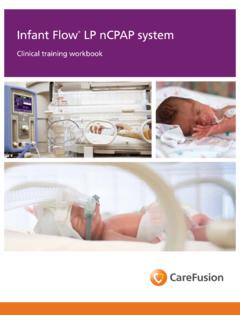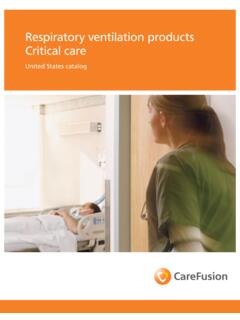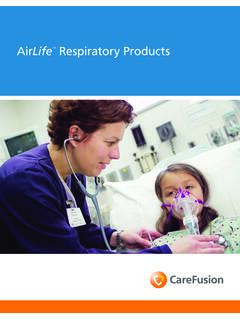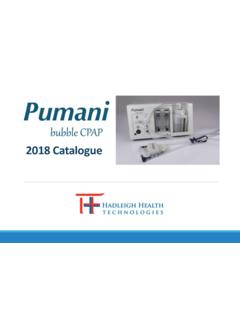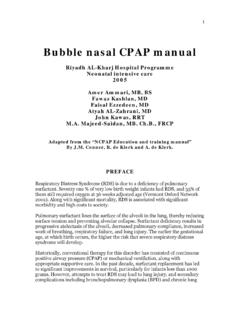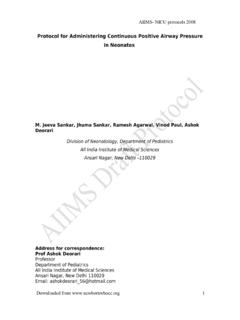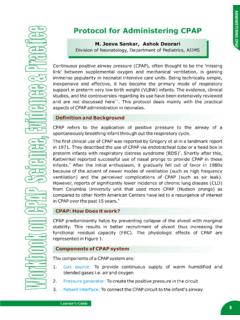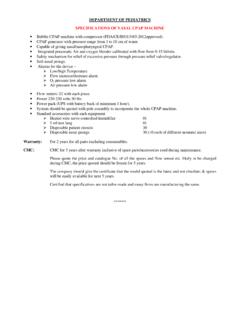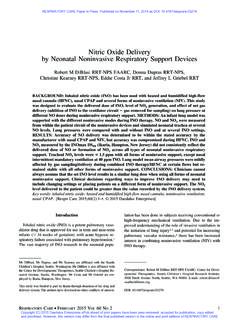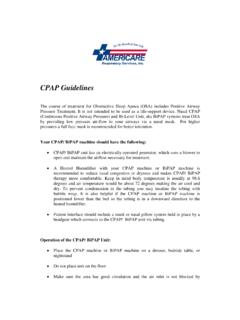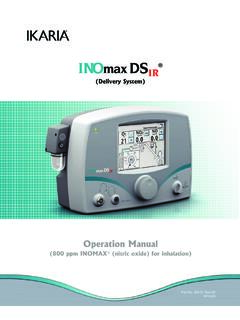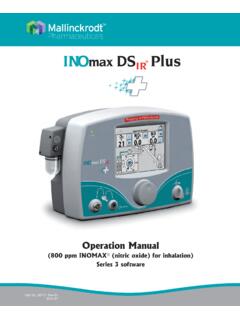Transcription of Infant Flow SiPAP - CareFusion
1 Infant Flow SiPAP 2015 CareFusion Corporation or one of its affliliates. All rights reserved. Objectives nCPAP overview Review of physiologic and desired effects of nCPAP Discuss indications, goals, contraindications, injuries, and issues associated with nCPAP application Discuss Variable and Bi-Level nCPAP Identify the components of the Infant Flow LP System and its application Discuss the final check and routine inspection, application tips, warnings and cautions of nCPAP Review the clinical management, monitoring, assessment, positioning and failure of nCPAP Summary of nCPAP 2015 CareFusion Corporation or one of its affliliates. All rights reserved. nCPAP - Overview nCPAP is the application of a continuous distending pressure to the airways Primarily used for maintaining lung expansion in conditions in which the alveoli tend to collapse or fill with fluid 2015 CareFusion Corporation or one of its affliliates.
2 All rights reserved. nCPAP Overview (cont.) Technique used on spontaneously breathing neonates in an attempt to prevent the need for mechanical ventilation Initial goal was to attempt a new strategy to reduce the already high mortality rates (75%) and chronic morbidities common to premature infants receiving mechanical ventilation during this time 1,2 2015 CareFusion Corporation or one of its affliliates. All rights reserved. 1 Von Reuss AR. Diseases of the Newborn. London: John Bale and Sons, 1921. 2 Berger, T., Fontana, M., Stocker, M. The journey towards lung protective respiratory support in preterm infants. Neonatology, 2013; 104:265-274. Physiologic and desired effects of nCPAP Physiologic effects of nCPAP Major fundamental difference between nCPAP and mechanical ventilation nCPAP is unable to effectively sustain alveolar ventilation during apnea, and, therefore, patients must be able to generate all of the breathing efforts1 2015 CareFusion Corporation or one of its affliliates.
3 All rights reserved. 1 Sankar, M., Sankar, J., Agarwal, R., Paul. V., Deorari, A. Protocol for administrating continuous positive airway pressure in neonates. AIIMS-NICU protocols. 2008. Physiologic effects of nCPAP (cont.) Spontaneous breathing at a sustained distending pressure augments: Venous return1 Promotes improved alveolar recruitment and stabilization1 nCPAP mimics the natural physiologic reflex, grunting that is frequently exhibited in infants with low lung compliance and low end-expiratory volume2 2015 CareFusion Corporation or one of its affliliates. All rights reserved. 1 Sankar, M., Sankar, J., Agarwal, R., Paul. V., Deorari, A. Protocol for administrating continuous positive airway pressure in neonates.
4 AIIMS-NICU protocols. 2008. 2 DiBlasi, R. Nasal continuous positive airway pressure ( cpap ) for the respiratory care of the newborn Infant . RC Journal. 2009, September; 54(9). Physiologic effect of nCPAP nCPAP does not have the same high risks of barotrauma and infection that accompany mechanical ventilation1 Open lung approach used to manage newborns predisposed to developing airway instability, edema and atelectasis2 2015 CareFusion Corporation or one of its affliliates. All rights reserved. 1 Bonner, K., Mainous, R. The nursing care of the Infant receiving bubble cpap therapy. Advances in Neonatal Care. 2008, Vol. 8(2):78-95. 2 DiBlasi, R. Nasal continuous positive airway pressure ( cpap ) for the respiratory care of the newborn Infant .
5 Respir Care. 2009, September; 54(9). Desired effects of nCPAP 2015 CareFusion Corporation or one of its affliliates. All rights reserved. The presence of positive pressure during the expiratory phase prevents alveolar collapse when surfactant is not present Desired effects of nCPAP (cont.) Increased transpulmonary pressure and functional residual capacity (FRC)1,2 Prevention of alveolar collapse and decreased intrapulmonary shunt1,2 Improved compliance1 Surfactant conservation1,2 Increased airway diameter1,2 Splinted airway and diaphragm1,2 Stimulated lung growth1 Reduced apnea, work of breathing, and lung injury1,2 2015 CareFusion Corporation or one of its affliliates.
6 All rights reserved. 1 DiBlasi, R. Nasal continuous positive airway pressure ( cpap ) for the respiratory care of the newborn Infant . Respir Care. 2009, September; 54(9). 2 Sankar, M., Sankar, J., Agarwal, R., Paul. V., Deorari, A. Protocol for administrating continuous positive airway pressure in neonates. AIIMS-NICU protocols. 2008. With an increased FRC, you anticipate: Lung compliance improves Work of breathing improves PaO2 increases PaCO2 decreases 2015 CareFusion Corporation or one of its affliliates. All rights reserved. 1 Bonner, K., Mainous, R. The nursing care of the Infant receiving bubble cpap therapy. Advances in Neonatal Care. 2008; 8:78-95 2 Sankar, M.
7 , Sankar, J., Agarwal, R., Paul. V., Deorari, A. Protocol for administrating continuous positive airway pressure in neonates. AIIMS-NICU protocols. 2008. Discuss indications, goals, contraindications, injuries, and issues associated with nCPAP application Indications for nCPAP Apnea of Prematurity - obstructive and/or mixed apnea Respiratory Distress - tachypnea, and/or retractions Respiratory Distress Syndrome (RDS) Transient Tachypnea of the Newborn (TTN) Bronchopulmonary Dysplasia (BPD) Weaning/Liberation from the ventilator 2015 CareFusion Corporation or one of its affliliates. All rights reserved. 1 Deakins, K. Non-invasive respiratory support in the neonatal intensive care unit.
8 Clinical Foundations. 2009; 1-11. 2 Sankar, M., Sankar, J., Agarwal, R., Paul. V., Deorari, A. Protocol for administrating continuous positive airway pressure in neonates. AIIMS-NICU protocols. 2008. Goals of nCPAP nCPAP is a method that achieves optimal lung inflation with results in adequate oxygenation and ventilation, and hopefully, less chronic lung disease The goal is to achieve the lowest possible pressure to maintain open alveoli without over-distention Generally well tolerated in part because infants are obligatory nasal-breathers 2015 CareFusion Corporation or one of its affliliates. All rights reserved. DiBlasi, R. Nasal continuous positive airway pressure ( cpap ) for the respiratory care of the newborn Infant .
9 Respir Care. 2009, September; 54(9). Contraindications for using nCPAP Upper airway abnormalities1,2 Tracheoesophageal fistula1 Severe cardiovascular instability1,2 Unstable respiratory drive with frequent apneic episodes resulting in desaturations and bradycardia1,2 Ventilatory failure as indicated by the inability to maintain PaCO2 <60 torr and pH > ,2 Diaphragmatic hernia1 2015 CareFusion Corporation or one of its affliliates. All rights reserved. 1 Nicks, J. cpap , SiPAP , High Flow Nasal Cannula in Infants: Which should you choose, when, and why? 2014. 2 Sankar, M., Sankar, J., Agarwal, R., Paul. V., Deorari, A. Protocol for administrating continuous positive airway pressure in neonates.
10 AIIMS-NICU protocols. 2008. Nasal injury Leading factors Tight fitting interfaces Frequency of assessment /adjustment Duration of nCPAP nCPAP level required Birth weight 2015 CareFusion Corporation or one of its affliliates. All rights reserved. Squires, A., Hyndman, M. Prevention of nasal injuries secondary to NCPAP application in ELBW infants. Neonatal Network. 2009; 28(1):13-27. Nasal injury (cont.) Types Nasal excoriation1,2 Scarring1,2 pressure necrosis1,2 Septal distortion1,2 2015 CareFusion Corporation or one of its affliliates. All rights reserved. 1 Deakins, K. Non-invasive respiratory support in the neonatal intensive care unit. Clinical Foundations.
